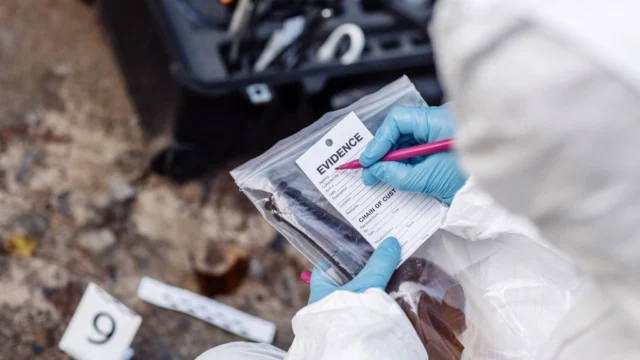Ever watched a crime show where a detective finds a hair strand or a fingerprint, and the case is solved? A tiny hair strand, a drop of blood, or even a fingerprint smudge can be the key to crack a mystery.
Welcome to the fascinating world of forensic evidence—where science meets justice, and small clues tell big stories.
In 2025, science has advanced more than anything. In addition, forensic science has become a powerful asset. It aids to uncover the truth, catch the right person, and sometimes even free the innocent.
So, whether you’re a law student or just curious about how criminal investigations really work, you will find everything in this blog!
What Is Forensic Evidence?
Forensic science is a study to connect people, places, and criminal activities, where scientific methods help in the investigation and resolution of criminal cases (Feldman, 2009).
The pioneer in forensic science, Dr. Edmond Locard said, “Every contact leaves a trace.” (Saferstein, 2007).
It aids in pinpointing the criminal, the time of the crime, and the way in which the crime was committed. In addition, it provides “who, what, when, where, and how” answers.
Hence, it helps police and courts find out what happened, who was involved, and whether someone is guilty or innocent.
Types of Forensic Evidence Used in Criminal Cases
Following are the common six types of forensic evidence used to solve criminal cases:
DNA Evidence
DNA is the most basic form of identity, and almost every human has a unique one. In addition, it’s an important forensic tool as the DNA left on the crime scene aids experts to trace the guilty. In general, one nanogram of DNA is adequate to produce a good result (Norrgard, n.d.).
Fingerprint Analysis
According to Locard’s Exchange System, when two objects meet, there’s an exchange of materials between them. In addition, the marks left on the object are fingerprints. Furthermore, these are unique to every individual and are a potent form of identification.
Ballistics and Firearm Examination
Firearm related evidence, such as bullet, gunshot residue, etc are a great forensic tool in investigation.
Toxicology Report
It aids in finding out the presence of drugs, alcohol, or other toxic substances. Thus, they help find the real cause of death in cases involving overdose, poisoning, or foul play.
Digital Forensics
Use of electronic devices and online records are useful in forensic. In addition, it analyzes devices, smartphones, communication patterns, location, and even digital footprints.
Trace Evidence (Hair, Fiber, etc)
These are the types of evidence which are visible to the naked eye. In addition, it includes fiber, hair, soil, glass, etc. Furthermore, experts compare these with known samples to make connections between suspect, crime scene, and victim.
These are the common types of forensic evidence used by experts to solve crime and punish the guilty. Also, if you are a law student and have to work on forensic evidence project then it’s best to connect with expert law assignment services to get the perfect results.
The Process: How Forensic Evidence Is Collected and Analyzed
The process begins at the crime scene. The experts carefully collect all the evidence. Also, they make sure to handle everything properly to avoid contamination. Thus, this process is called chain of custody.
After that, the evidence goes to a forensic laboratory, where scientists test it using various methods.
For example, DNA is tested using PCR (Polymerase Chain Reaction), and toxic substances are detected using machines like GC-MS (Gas Chromatography-Mass Spectrometry).
Role of Forensic Evidence in Court
Forensic plays a vital role in modern crime trials and uncover truths.
Admissible of Evidence
Forensic evidence must follow the standards of law to be admissible in court. Hence, it should be relevant, real, and reliable. Also, the experts have to simplify the proof to present it to the jury for their better understanding.
Influence of Jury’s Decision
These proofs heavily influenced the jury’s decision. Therefore, it should be clear, well-explained, and easy to understand. Also, DNA, fingerprint, and other types of proofs are often more persuasive and convincing.
Challenges in Forensic Investigations
Indeed, forensic evidence is powerful. However, there are some limitations of forensic evidence. These are:
- Human error: Experts can also mess up the evidence collection process. Hence, it makes difference in results
- Bias: Personal bias can influence a forensic examiner’s examination.
- Improper handling of proof: If evidence is not handled carefully, it can be spoiled and become useless in court.
- False confidence: Some people think forensic science is always correct because of crime shows. However, not all methods are 100% reliable.
The Future of Forensic Science
As technology grows, forensic science continues to improve. Here are some trends to watch:
AI and Machine Learning
According to Oxygen Forensics, AI aids to work on large databases and look for patterns and elements that might have been missed from humans. In addition, it also involves social media activity, emails, and other digital data.
3D Scanning and Printing
3D scanning will aid in capturing detailed representations of crime scenes. Also, it creates replicas for further investigation.
Nanotechnology
It studies proofs in nano-scale level. In addition, it trace amounts of proofd not detectable by other ways.
Final Words
Forensic evidence plays a vital role in solving crimes. From DNA and fingerprints to digital data, this science-based approach helps find the truth and deliver justice. It can prove guilt, free the innocent and uncover secrets that would otherwise stay hidden.
As technology evolves, forensic science will continue to be one of the most important tools in the criminal justice system.
FAQs
Can a crime be solved without forensic evidence?
Yes, crime can be solved without forensic evidence. However, it makes it much easier to prove what happened and who was responsible.
What is the most reliable forensic evidence?
DNA evidence is often the most reliable because it is unique to each person.
What is the difference between forensic science and forensic evidence?
Forensic science is the field of study that applies science to criminal investigations. Forensic evidence is the actual proof—like DNA, fingerprints that is collected and studied using forensic science methods.
Can forensic evidence be used to prove someone is innocent?
Yes! Forensic science doesn’t just catch criminals. But, it can also clear innocent people. Many wrongful convictions have been overturned thanks to DNA and other forms of forensic testing.







